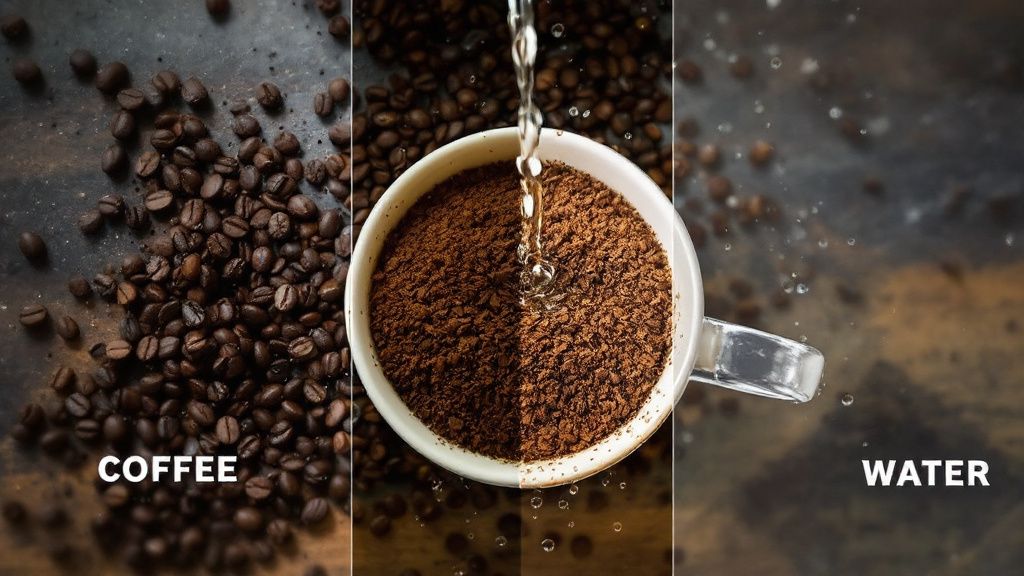
How Water-to-Coffee Ratio Affects Strength and Flavor
Share
TLDR;
The water-to-coffee ratio directly controls both the strength and flavor of your coffee. A lower ratio (more coffee, less water) produces a stronger, bolder brew, while a higher ratio (less coffee, more water) gives a lighter, milder cup. The ideal ratio depends on brewing method, desired taste, and precision in measuring.
Understanding the Science Behind Coffee Strength

Strength in coffee means the concentration of dissolved coffee solids in your cup. This is measured as Total Dissolved Solids (TDS). A higher TDS means a stronger coffee. Extraction yield is the percentage of coffee compounds pulled from the grounds into the water.
Brew ratio controls both strength and extraction.
-
Too low a ratio can over-extract, making coffee bitter.
-
Too high a ratio can under-extract, making coffee sour or weak.
When you adjust the ratio, you change the balance between coffee solubles and water. Milk & Honey Coffee Co. recommends understanding that strength and extraction are connected but not identical. Strong coffee does not always mean well-extracted coffee.
Standard Coffee-to-Water Ratios by Brewing Method

Different brewing methods need different ratios because of brew time, grind size, and pressure.
Pour-Over: 1:15 to 1:18
French Press: 1:12 to 1:15
Drip: 1:15 to 1:17
Espresso: 1:2 to 1:3
Cold Brew Concentrate: 1:4 to 1:5 (before dilution)
Reason for variation:
-
Immersion methods like French press need a lower ratio for enough strength.
-
Pressure brewing like espresso needs much less water to achieve high concentration.
-
Drip and pour-over need a balance between flow rate and extraction.
How Adjusting Ratio Impacts Flavor Profile

Changing your ratio shifts the flavor balance.
Higher coffee-to-water ratio (more coffee):
-
Stronger body and mouthfeel
-
More intense flavors, sometimes bitter if over-extracted
Lower coffee-to-water ratio (less coffee):
-
Lighter body
-
Can taste brighter, more acidic, sometimes sour if under-extracted
Flavor extraction balance:
-
Under-extracted coffee often tastes sour and thin.
-
Over-extracted coffee often tastes bitter and harsh.
Tools and Techniques for Precision Brewing

To get consistent results, measure both coffee and water accurately.
Recommended tools:
-
Digital scale for grams
-
Timer for brew time control
-
Thermometer for water temperature
- Consider using filtered water for coffee to avoid off-flavors from chlorine or excess minerals
Tips:
-
Always measure coffee and water by weight, not volume
-
Use consistent grind size for your brew method
-
Keep water temperature between 195°F and 205°F for optimal extraction
Cold Brew and Specialty Variations in Ratio

Cold brew is unique because it uses a high coffee concentration and long steeping time.
Cold brew base: 1:4 to 1:5 coffee-to-water ratio for concentrate
Dilution: Often diluted with water or milk at 1:1 or 1:2 before serving
Specialty methods:
-
Turkish coffee: 1:5 to 1:7, very fine grind, unfiltered
-
Moka pot: About 1:10, medium-fine grind, high pressure from steam
-
Americano: Espresso diluted with hot water, typically 1:3 to 1:4 espresso-to-water ratio
Troubleshooting Based on Ratio Adjustments

Use these quick checks to fix taste problems.
Bitter coffee:
-
Increase water slightly
-
Use coarser grind
-
Reduce brew time
Sour coffee:
-
Use more coffee for stronger extraction
-
Use finer grind
-
Extend brew time slightly
Weak coffee:
-
Reduce water or increase coffee
-
Check grind size for better extraction
Heavy or muddy coffee:
-
Increase water slightly
-
Use a cleaner grind size and filter method
How to Dial In Your Perfect Ratio

The ideal ratio is personal. Start with a baseline and adjust in small increments.
Steps:
-
Begin at 1:16 ratio
-
Brew, taste, and note the result
-
Adjust ratio by small changes, like 1:15 or 1:17
-
Keep a brew log of ratios, grind size, brew time, and taste notes
Example log entry:
-
Brew: Pour-over, 20g coffee, 320g water, 3:00 min brew time
-
Result: Balanced sweetness and acidity, medium body
Practical Considerations from an Expert Perspective

From Milk & Honey Coffee Co., we see patterns in customer preferences.
-
People who drink coffee black tend to prefer slightly stronger ratios (1:14 to 1:15)
-
Those adding milk often prefer a more concentrated base so the milk does not dilute flavor too much
-
Lighter roasts often benefit from slightly lower ratios to bring out acidity without overwhelming bitterness
-
Dark roasts can handle higher ratios without losing flavor depth
Summary and Key Takeaways on Water-to-Coffee Ratio

-
Strength is about concentration, extraction is about how much is dissolved
-
Ratios differ by brewing method due to brew time, grind size, and pressure
-
Small adjustments in ratio have a large impact on taste
-
Measuring accurately with a scale ensures consistency
-
Cold brew, Turkish, Moka, and Americano each have unique ratio needs
-
Troubleshooting with ratio changes helps correct flavor issues quickly
- Keep track of what works best for your taste preference
